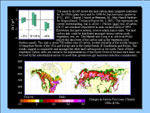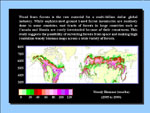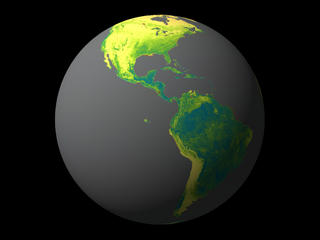SATELLITE DATA HELP RESEARCHERS TRACK CARBON IN NORTHERN HEMISPHERE FORESTS
How much carbon is being "absorbed" by forests in the Northern Hemisphere?
Image 1NASA-funded Earth Science researchers, using high-resolution maps of carbon storage derived from NASA-developed satellite data sets, suggest that forests in the United States, Europe and Russia have been storing nearly 700 million metric tons of carbon a year during the 1980s and 1990s.
Scientists hope to understand to what extent carbon is stored in the Earth's forests because of the need to account for the fate of the carbon released into the Earth's atmosphere in the form of carbon dioxide from fossil-fuel combustion. NASA's research will further understanding of the role that such "sinks" play in sequestering carbon and the impact climate change has on agriculture, rangelands and forests.
Image 2The accumulation of carbon dioxide in the atmosphere is considered to be the primary forcing agent for global climate change, so forecasts of future climate require that the fate of carbon dioxide released into the atmosphere be understood.
Right now, scientists have inferred that there is a sink of 1 to 2 billion tons of carbon into the land regions of the northern hemisphere, which corresponds to some 15 to 30 percent of the global annual industrial carbon emissions.
|
Image 3 PULSE OF THE PLANET Click on image for animation |
Caption for Image 3: Satellite observations of vegetation greenness is a measurement of the amount and functioning of plants which consume atmospheric carbon dioxide and synthesize sugars. Watching the greening over the three years shown is a good indication of carbon fixation. Credit: NASA / ORBIMAGE |
"A critical challenge for Earth scientists is to reduce the uncertainty in this estimate and to derive its geographical variation," said Compton Tucker of NASA's Goddard Space Flight Center, Greenbelt, Md.
The researchers exploited high-resolution spatial coverage data of northern forests available only through NASA-built weather satellites in their study.
|
Image 4
THE CARBON CYCLE Click on image for animation |
Caption for Image 4 and animation: |
Using detailed forest-inventory data from 171 provinces in six countries, they derived and validated relationships between forest "greenness" measured from satellites and the "hands-on" measurements of the amount of carbon contained in the woody biomass of forests. The robust relationship thus obtained allowed them to produce high-resolution maps of carbon stocked in about one-and-a-half billion hectares (roughly, a little more than one-and-a-half times the size of the United States) of northern forests located above the 30th parallel.
"We identified carbon sinks, areas where forests were storing carbon, and sources, areas where forests were losing carbon, by comparing the most recent carbon-stock maps of the late 1990s with those from the early 1980s," said Ranga Myneni of Boston University.
U.S. forests soaked up 140 million tons of carbon a year. With the exception of Canada's boreal forests, which were found to be losing carbon, most northern forests were storing carbon. Russia, the country with most forests in the Northern Hemisphere, accounted for almost 40 percent of the biomass carbon sink.
The researchers suggest a longer growing season from climate-warming in the north, fire suppression and forest re-growth in the United States, better forest management in the Nordic countries and declining harvests in Russia as possible reasons why some forests are storing carbon.
They also suggest increased incidence of fires and infestations as possible reasons why some Canadian forests are losing carbon. "The fact that the forests in different areas appear to be behaving differently means that there is no substitute for monitoring them from space, in view of the global coverage provided by satellite observations," said Jiarui Dong of Boston University.
These results of a NASA-funded study will be published in the December
18 issue of the Proceedings of the National Academy of Sciences
(PNAS). An electronic version of this article will appear
in an early edition of PNAS December 11 at:
www.pnas.org
The work was funded by NASA Headquarters' Earth Science Enterprise, a long-term research program dedicated to understanding how human-induced and natural changes affect our global environment.
Other images showing the Pulse of the Planet:
Click here to view a medium resolution still of the globe
Click here to view a high resolution still of the globe
Click here to view an animation of North American greening
Click here to view a medium resolution still of the North American greening
Click here to view a high resolution still of the North American greening
Click here to view an animation of Europe/Asia greening
Click here to view a medium resolution still of the Europe/Asia greening
Click here to view a high resolution still of the Europe/Asia greening



